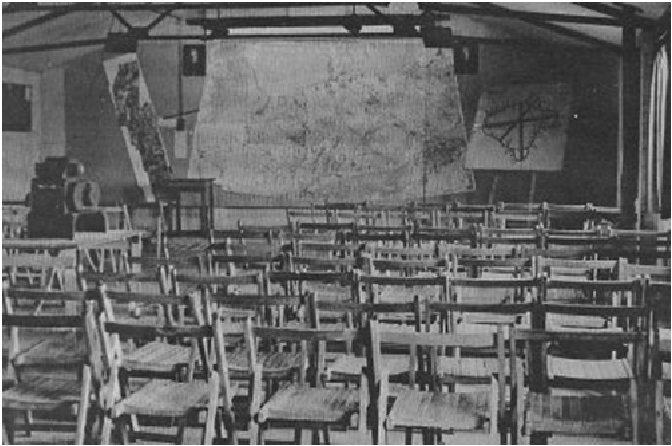Navigation
The Raid on Nuremburg
The code name of the target, “Grayling,” was sent to all group commanders and in turn to stations and squadron commanders. Security was immediately put into force. All outgoing phone calls were blocked and those incoming were intercepted, cutting stations off from the outside world as preparations for the raid began.

The target tonight is Nuremberg on the river Pegnitz some 90 miles to the north of Munich. As a military target, Nuremberg is an important industrial city with a population of 350 000 and a centre for general and electrical engineering. The famous M.A.N. works produce armaments of all kinds there and, since their large factory in Berlin was bombed, Siemens plant in Nuremberg has stepped up production of its electric motors, searchlights and firing devices for mines.
There we were, 112 of us each with our own private thoughts. But all thinking on similar lines, such as “Will our crew be one of the lucky ones?, Is this it? Will I ever see the wife again?
And so on but all around the same theme being 'will i live ore die?' Will I survive or will I die?
It was obvious that we all had the same thing in mind because a noisy and jocular dispersal was the norm after briefing but on this occasion we just sat and looked at each other, no words passed but the message was clearly conveyed through an atmosphere that was electric.
Flight Sergant L. Nugent, HX241 EY-P 78 Squadron.
source: " The Nuremberg Raid, "Martin Middlebrook.
Very nice animated video of a night mission

795 bombers had taken off, 2 crashed at their bases and 55 turned back with various unservices abilities, 738 heavy bombers then followed the planned route to Nuremberg.
It is apparent that on clear nights the growing technical skill of the German night-fighter controllers and the new Lichtenstein airborne radar units combine with the German ability to track RAF H2S and IFF transmissions in inflicting unacceptable loss rates on the attacking force.
Flying over the main land, they would soon be out of range from the UK based "Gee" navigation beacons and rely on dead reckoning from the forecast winds. Selected crews were tasked to radio back their estimate of the actual winds, which would be averaged at group HQ and rebroadcast. Navigators would then use this revised wind estimate to adjust their heading and regain track. The system depended on many accurate calculations by navigators in the cold and cramped bombers and should have kept the 68 mile long stream concentrated on the planned route and allow crews to bomb the target at their allocated times.
Many of the Luftwaffe's night fighters were equipped with a pair of upward pointing canon designed to allow the fighter to position beneath an RAF Bomber, out of sight from the gunners, and open fire at close range with inevitably lethal effect. Codename "Schrage Musik".
It was now 01:00 hour . In the last 60 minutes since the bomber stream crossed the German border 59 Lancasters and Halifaxes had been shot down. Never before or since has so much airborne destruction taken place in a single hour. The sight of heavy bombers falling in flames at the rate of one every minute must have shaken the RAF crews, but all remaining aircraft now pressed on to the target. However, the actual not forecast winds, had blown most of the stream to the north and east of the planned turning point to Nuremberg and cloud, the lack of which had left the bombers exposed to attack, now began to form a thick layer below them, covering the area.
The attack on Nuremberg was planned to commence at 0105 when 86 Pathfinder blind markers and supporters were to bomb. The main force of 690 Lancasters, Halifaxes and Pathfinder backers-up were to bomb from 0110 to 0122, blasting the centre of Nuremberg with over 3000 tons of high explosive and almost 70,000 incendiaries. However, the adverse winds and the nightfighter battle had badly scattered and depleted the force and only 512 bombers were to reach the Nuremberg area. This was still a formidable force and its bomb loads could have inflicted severe damage on the target, but the Pathfinders could not see their aiming point due to thick cloud cover and most had drifted well east of track. Only a few were equipped with cloud markers and these were dropped late and some up to 10 miles east of Nuremberg. When most of the main force arrived, about 5 minutes late and still under nightfighter attack, its bombs fell in open countryside.
Most of the returning crews reported that they had bombed Nuremberg but subsequent research showed that approximately 120 aircraft had bombed Schweinfurt, 50 miles north-west of Nuremberg. This mistake was a result of badly forecast winds causing navigational difficulties. 2 Pathfinder aircraft dropped markers at Schweinfurt. Much of the bombing in the Schweinfurt area fell outside the town and only 2 people were killed in that area. The main raid at Nuremberg was a failure. The city was covered by thick cloud and a fierce cross-wind which developed on the final approach to the target caused many of the Pathfinder aircraft to mark too far to the east. A 10-mile-long creepback also developed into the countryside north of Nuremberg. Both Pathfinders and Main Force aircraft were under heavy fighter attack throughout the raid. Little damage was caused in Nuremberg.
William Uyen
November 18, 1943 HisStory during the Air-battle of Berlin March 31, 1944

